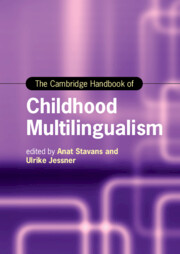Book contents
- The Cambridge Handbook of Childhood Multilingualism
- Cambridge Handbooks in Language and Linguistics
- The Cambridge Handbook of Childhood Multilingualism
- Copyright page
- Contents
- Figures
- Tables
- About the Editors
- Contributors
- Acknowledgments
- Multilingualism Is Not Bilingualism +1: An Introduction
- Part One Becoming and Being a Multilingual Child
- Part Two Cognition and Faculties in Multilinguals
- Part Three Family Language Policy
- Part Four Language(s) and Literacy of Multilingual Children through Schooling
- Part Five Socialization in Childhood Multilingualism
- 21 Building a Plurilingual Identity
- 22 Multilingual Parenting in the United States: Language, Culture and Emotion
- 23 The Development of the Heritage Language in Childhood Bi-/Multilingualism
- 24 Social Cohesion and Childhood Multilingualism in South Africa
- 25 Growing Up in Multilingual Societies: Violations of Linguistic Human Rights in Education
- Part Six Multilingual Children’s Landscape
- Subject Index
- Country Index
- Language Index
- References
24 - Social Cohesion and Childhood Multilingualism in South Africa
from Part Five - Socialization in Childhood Multilingualism
Published online by Cambridge University Press: 18 August 2022
- The Cambridge Handbook of Childhood Multilingualism
- Cambridge Handbooks in Language and Linguistics
- The Cambridge Handbook of Childhood Multilingualism
- Copyright page
- Contents
- Figures
- Tables
- About the Editors
- Contributors
- Acknowledgments
- Multilingualism Is Not Bilingualism +1: An Introduction
- Part One Becoming and Being a Multilingual Child
- Part Two Cognition and Faculties in Multilinguals
- Part Three Family Language Policy
- Part Four Language(s) and Literacy of Multilingual Children through Schooling
- Part Five Socialization in Childhood Multilingualism
- 21 Building a Plurilingual Identity
- 22 Multilingual Parenting in the United States: Language, Culture and Emotion
- 23 The Development of the Heritage Language in Childhood Bi-/Multilingualism
- 24 Social Cohesion and Childhood Multilingualism in South Africa
- 25 Growing Up in Multilingual Societies: Violations of Linguistic Human Rights in Education
- Part Six Multilingual Children’s Landscape
- Subject Index
- Country Index
- Language Index
- References
Summary
Studies of social cohesion and childhood multilingualism in South Africa are important because of the confluence of social space and race in apartheid South Africa. A sociology of language approach is followed where the social spaces and structures in society are brought in relation to the multilingual repertoires of early childhood multilinguals. A main finding is that there is a paucity of research that describes the multilingual repertoires of early childhood multilinguals in South Africa; there is a need for longitudinal studies. Findings from adjacent fields indicate that there is widespread early childhood multilingualism in South Africa and that multilingualism is related to social cohesion in different ways. First, White South Africans see the addition of an African language to their repertoires as a way to foster social cohesion. Second, children of the developing Black middle class are exposed increasingly to spaces where populations are more integrated and where English is paramount. Finally, all studies reviewed in the chapter indicate a severe gap between the multilingual experiences of childhood multilinguals in South Africa and monolingual experiences in school where they are either taught in the home language or in English.
Keywords
- Type
- Chapter
- Information
- The Cambridge Handbook of Childhood Multilingualism , pp. 555 - 577Publisher: Cambridge University PressPrint publication year: 2022



